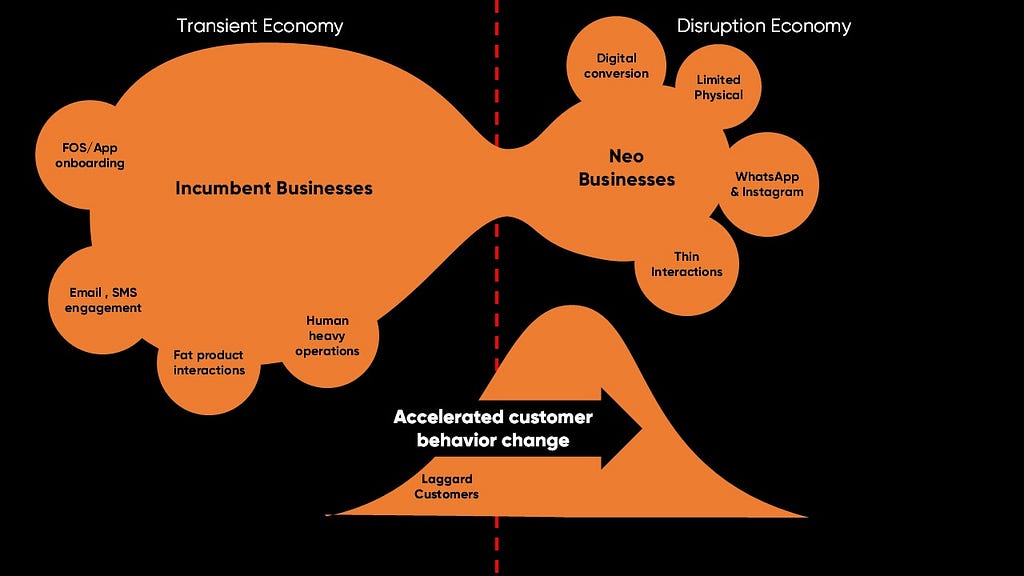
Rise of Neo Businesses
The nature of building digital businesses has changed. Fundamentally.
We’re not just digitizing old models anymore. We’re operating in what can only be called the Disruption Economy — where customers have leapfrogged in behavior, and a new breed of companies has emerged to serve them in ways incumbents simply can’t keep up with.
These are Neo Businesses.
Fast, agile, tech-native — yes. But more importantly, they are thin, in-context, and behaviorally tuned. They don’t push customers into apps or long journeys. They meet them in moments — through WhatsApp, PWAs, mini-apps, voice interfaces, or embedded flows. No friction. No waiting. No bloated UIs.
In contrast, traditional businesses are still clinging to a transient economy mindset.
Heavy field ops. SMS engagement. Call center dependencies. Thick UI platforms loaded with menus and effort. It worked once — but the market has moved on. And so have the users.
Customers, having been hyper-exposed to digital choices, are no longer impressed by availability. They expect value — unique, fast, seamless value. They aren’t waiting to be onboarded. They want to be served in flow, in context, and with minimal effort.
This shift has broken the backbone of how we traditionally think about UX.
Traditional UX process is failing in the disruption economy
The UX process, in its current form, was built for a slower, more predictable world. But that world is long gone. In the disruption economy, where customer expectations have leapt forward, the old methods not only fall short — they actively hold businesses back.
Let’s break down why.
It is Still Focused on Reskinning Channels: Too often, UX is mistaken for visual refreshes — UI cleanups, reorganized menus, minor flow improvements. There’s little reflection on whether the underlying interaction model is still relevant at all.
I remember when companies invested heavily in desktop website redesigns, even as mobile usage had already overtaken. It took years — and lost opportunities — for them to pivot. We’re now repeating the same mistake with mobile apps. Customers have moved to micro-touchpoints: chat interfaces, embedded flows, voice prompts, and thin experiences. Yet the UX process still optimizes for pages and screens.
The challenge with the UX process remains as it still does not focus on really understanding how customers want to engage with businesses through various channels. UX teams are polishing surfaces while the floor beneath has already shifted.
It Overlooks Value in Favor of Usability: Traditional UX focuses heavily on improving flow — reducing friction, clarifying labels, improving discoverability. All important. But none of it matters if the product itself doesn’t deliver value that feels immediate and relevant.
Today, users judge a product by its utility — not just its aesthetics. If there’s no clear value in the first 30 seconds, the experience is dead on arrival. Customers now more than ever engage with the value of the product first than how smooth the experience is made out to be. Optimizing journeys means little if you haven’t evaluated whether those journeys are worth taking at all.
Speed to Market: The old UX process assumes time: time to research, to design, to iterate, to test. But Neo Businesses are operating in a hyper-competitive space where time is the biggest risk.
If a process takes months to deliver validated designs, the market may have moved on. Startups need to launch quickly, test real behavior, and adapt in real time. UX can no longer be a standalone pre-build phase. It has to run in parallel with product strategy, engineering, and growth.
Anything slower becomes drag.
Prioritizes visual/conceptual wow Over Buildability: Designing the experience is one thing. Getting it built to a high level of quality — fast — is another. In many cases, the handoff between design and development is where things fall apart.
Today’s customers compare your product experience not to your category competitors, but to everything else on their phone. If your app feels less polished than Uber, Swiggy, or Instagram, it fails. The expectation bar has risen — and UX has to design with real constraints, tech feasibility, and delivery clarity in mind.
Buildability isn’t a technical concern anymore. It’s a user experience concern. With the multitude of well-crafted experiences to compare with customers will now be quite finicky when it comes to evaluating your product experience. A high focus on buildability is key for experience design to be successful.
Ends Too Early: In many organizations, the UX team is involved during the early stages — research, flows, mockups. Once the handoff happens, they step back.
But Neo Businesses don’t operate in phases. They operate in loops. You can’t create a meaningful experience without staying through launch, post-launch, stabilization, and optimization. You have to see what performs, what doesn’t, and how real behavior unfolds. To enable success for the product, a partnership along the whole product lifecycle is needed. It is only when you have seen the product launch, stabilize, and grow that certainty of success can be attained.
Otherwise, you’re designing in theory — not reality.
The Path Forward
UX process has to be revisited. Not as a set of deliverables, but as a system that ties business value to behavior, behavior to design, and design to outcome. It needs to work across atypical channels. It must prioritize thin interactions, real-time adaptation, and continuous presence across the product lifecycle.
Because Neo Businesses don’t need more interfaces.
They need outcomes.
And UX, if it wants to stay relevant, must become the engine that drives them.
UX Is Failing Neo Businesses was originally published in UX Planet on Medium, where people are continuing the conversation by highlighting and responding to this story.